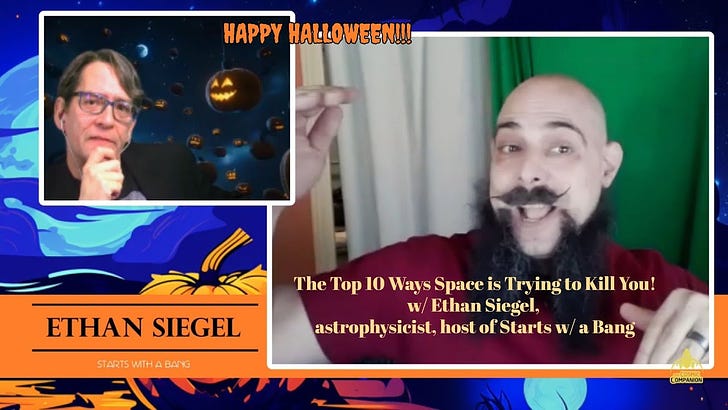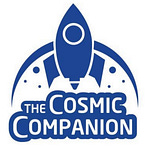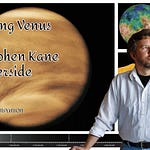HAPPY HALLOWEEN EVERYONE! (I mean, BOO!)
This week on The Cosmic Companion, for our Halloween Special, we’ll be looking at The Top 10 Ways Space is Trying to Kill You! Later in the show, we’ll be talking with astrophysicist and science educator Ethan Siegel, host of Starts with a Bang!
Let’s dive right in! Here are The Top 10 Ways Space is trying to Kill You!
#10: Alien Invasion: Now, planetary invasions by militant extraterrestrials, a staple of sci-fi, usually involve E.T. with a bad attitude, hell-bent on stealing our resources or turning us into appetizers. But let’s be real, the chances of this happening are slimmer than a stick insect on a diet.
Why? Well, it’s all thanks to our cosmic speed limit, the speed of light. Even traveling close to this breakneck pace, a trip to the nearest star would take years! So unless aliens have cracked the code on warp speed or they really like road trips, we’re probably safe. Extraterrestrial drones? Who knows?
#9: The Kessler Effect: As we keep sending more satellites into orbit above Earth, it’s getting a bit crowded up there. Imagine two satellites playing chicken and colliding. They shatter, creating more debris, which destroys more satellites, which creates more debris, and voila, we have the Kessler Effect— a domino effect of collisions creating a space junkyard above our planet. This ‘cloud of clutter’ could wreak havoc on satellites and spacecraft, including occupied space stations.
Although the immediate threat to people on Earth would be minimal, such a chain reaction of debris could cripple communications, guidance, weather forecasts, and space travel for decades or more to come.
#8: Coronal Mass Ejections (CMEs): Massive eruptions from the Sun are seen on a regular basis, and nearly all of these miss Earth. Were an extremely powerful CME to strike Earth, our electronics and electrical devices could go haywire and even catch fire.
Again, the number of deaths from such an event would be low, but such a scenario could plunge us into a world without electricity, leading to chaos.
#7: A Nearby Supernova: A supernova is a powerful and luminous explosion of a supermassive star. If such a stellar eruption were to occur close enough to Earth (within 30 to 50 light-years), it could have significant effects on our planet.
Right now, our cosmic neighborhood seems pretty chill. No nearby stars are wearing the ‘I’m about to go supernova’ sign. [<<< GLARE] But hey, the universe loves a good plot twist.
Enter stage left: rogue stars moving into our neighborhood during Earth’s joyride through the galactic plane, that could bring us closer to supernova territory. It’s like a cosmic game of musical chairs, and we’re just hoping we’re not left standing when the music stops!
#6: The Black Hole vs Earth: It’s like cosmic dodgeball with a twist. Both involve something hurtling towards us, triggering our planetary defenses. But while we might stand a chance against an asteroid, a black hole is a different beast. It’s not just massive, it warps space-time itself, devouring… You know what? This is about how it would go down…
[[
NEWSCAST:
[TYPEWRITERS]
Tanya: (Excitedly) Breaking news, folks! A black hole is heading towards Earth!
Tom: (Nonchalantly) Oh, like an asteroid? We’ve got that famous actor on speed dial.
Tanya: (Laughs) No, Tom. This isn’t a movie, and a black hole isn’t just a massive object. It’s a warp in space-time itself!
Tom: (Confused) Space. Time… what now?
Tanya: (Patiently) Imagine the universe is a trampoline. A black hole is like an elephant sitting in the middle. It gobbles up everything — planets, stars, even light!
Tom: (Wide-eyed) So… we can’t just… push it aside?
Tanya: (Shakes head) Afraid not, Tom. If it’s heading our way, we’d better hope humanity has a plan for interstellar travel. Which… by the way… We don’t.
Tom: (Nervously) I… I see. Well, that’s a lot to take in.
(Tanya exits)
Tom: (YELLS) Maybe if we all turn our fans on at once, we can blow it away?
]]
Before we hear about the top five ways space is trying to kill you, we welcome astrophysicist Ethan Siegel to the show:
#5: “Alien Virus Invades Earth: Imagine an alien virus landing on Earth aboard a meteorite. Sounds scary, right? But unless it’s tailor-made for Earthlings, it’s likely harmless.
Interestingly, however, we’ve found the same amino acids in space that are the building blocks of life on Earth. While this doesn’t guarantee extraterrestrial lifeforms have chemical similarities to life on Earth, it does tickle the imagination.
Could there be a cosmic connection between lifeforms across the universe, directed by the laws of chemistry and physics? The odds of an alien virus spelling disaster for life on Earth are slim, but in the vastness of the Cosmos, who knows?”
#4: Magnetar Mayhem: Picture a neutron star but give it a magnetic field so strong it would make Magneto blush. These overgrown toy magnets of the cosmos, called magnetars, are the most magnetic objects known.
Every star has its tantrums, but when a magnetar throws a fit, it’s a sight to behold, letting out a burst of radiation that could outshine thousands of suns. If one of these cosmic tantrums were directed at Earth, well, let’s just say we’d feel the burn.
#3: Star Struck: Picture this — a star passing by decides to stir up some trouble in our peaceful Oort Cloud, the icy neighborhood at the edge of our solar system. This celestial bully nudges one of the cloud’s mountainous residents, sending it streaking towards us like a rebellious comet with a ‘long-period’ attitude.
Now, this cosmic gatecrasher could potentially crash our Earth party with a dangerous one-sided celestial snowball fight. This is probably not likely to happen for a few million years at least, but keep it on your calendar, nevertheless.
#2: The Warming Sun Boils Away Oceans: As our Sun ages, it is gradually becoming hotter. In about a billion years or so — maybe less, maybe more, it will brighten up so much that Earth’s oceans will boil away, turning into steam.
Having the atmosphere full of steam may seem like an easy way to get a decent cuppa, as well as saving on sauna fees. However, it would lead to a runaway greenhouse effect, making Earth uninhabitable. In less than a billion years, the only living beings will likely be tardigrades, a few birds, and people who live in Arizona.
#1: Asteroid Arcade: Picture space as a giant game of cosmic bumper cars, with asteroids and comets zipping around. Every so often, one of these celestial speedsters heads straight for Earth, causing an impact event.
Most of these are just minor fender benders, but some have left some serious dents in Earth’s history, even playing a role in extinctions. A direct hit can cause quite the spectacle, leading to significant damage and even global climate changes.
In the year 4479, Comet Swift Tuttle could potentially strike Earth following a close encounter with Jupiter. Called “the single most dangerous object known to humanity,” an impact with Swift-Tuttle could be 25–30 times more disastrous than the impact that ended the age of dinosaurs.
Even a smaller impact could lead militaries around the globe to react to an “enemy attack” that never took place, potentially having calamitous consequences.
Dinosaurs didn’t have space programs. We do. Supporting space science means keeping an eye or two out for these incoming mountains. Probably a good idea.
Next week on The Cosmic Companion, we’ll be looking at the question of Why Do We Explore? We will be talking with Jon Waterman, creator of Atlas of Wild America. Make sure to join us starting on 4 November, for our only show of the month, as we enter the Holiday Season.
If you made it this far in the episode, I’m going to assume you enjoyed it. Or, you skipped to the end like reading a mystery novel. [SHRUG] Whatevs!
So, maybe you know someone else who might like The Cosmic Companion? Go ahead and subscribe, like, follow, and share all that good stuff anywhere you find our show.
Clear skies!
James
COLD AS DEATH OPEN: I am the Grimm Reaper. [CLEARS THROAT] No, not the one you’re thinking of — that’s my brother, Grim. I’m Grimm with two M’s. It was really confusing growing up. I tell fairy tales.
Here’s a brand-new musical fairy tale I just cooked up about a space traveler lost in space on Halloween. It’s called Lost Traveler, or Halloween on Earth…












Share this post